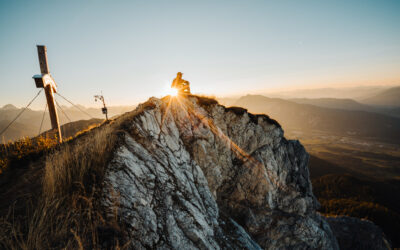On the Buddhism Sanctuary Trail – exploring Nepal in a new way
Great was the joy to have reached the Pikey Peak I. Some had never stood on such a high mountain © Josef Essl/Trail Angels
It was February 2022 when my good old friend, Günter Mussnig, founder and CEO of Trail Angels® contacted me and asked me if I would like to lead an Explorer Tour with a group in Nepal in 2022. Initially, I was a bit hesitant because I didn’t know what to expect, even though I already knew Nepal from my travels. Günter sensed my hesitation and said, “are you interested in Buddhism”? My ears perked up and without asking any more questions I agreed. Buddhism is omnipresent in Nepal, but for the vast majority of tourists traveling to Nepal it plays only a minor role. Mostly only at the beginning or at the end of the trekking trip the stupa in Bodnath, the Buddhist temple complex of Swayambhunath and the city of Patan (Lalitpur) in the Kathmandu valley are visited mostly in the fast run. And afterwards, one buys prayer flags to hang on the balcony or in the garden at home. One is indeed fascinated by the many temples, the people praying in beautiful robes, the colorful animal figures, the colorful prayer flags and much more. And also the beautiful circular or square mandalas, which have a religious meaning in Buddhism and Hinduism, magically attract the eyes of tourists. But Buddhism is not only omnipresent in Kathmandu, also in the rural regions the Buddhist faith shows itself in the form of mani walls, stupas, chörts and prayer wheels in the most different forms. These are very popular photo motifs, but probably only a few trekking tourists deal intensively with this religion, because primarily it is the impressive landscapes with the highest mountains in the world that one wants to see and experience. But why not combine trekking and Buddhism into a unique symbiosis? Is it possible? Yes, with the Buddhism Sanctuary Trail Buddhism, landscape, mountains and culture merge into one.

The Bodnath Stupa is a center of Buddhism. It is one of the largest stupas in the world and was added to the list of World Heritage Sites in 1979 © Josef Essl/Trail Angels
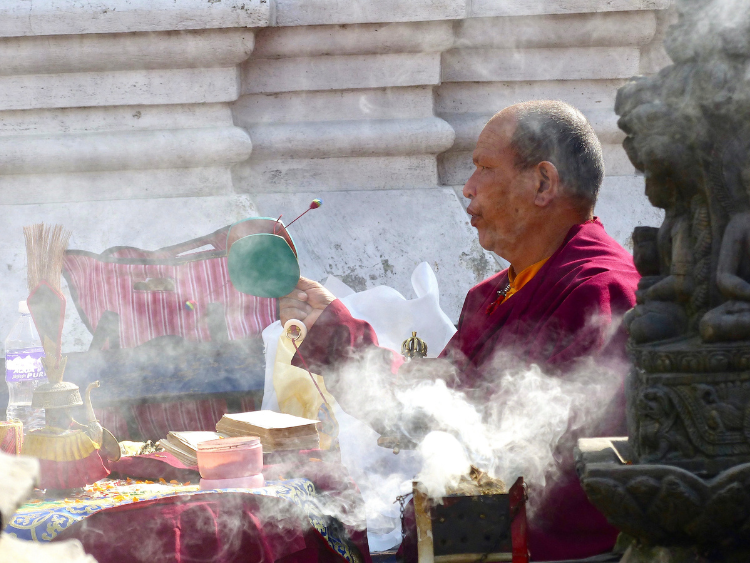
A Buddhist monk praying atop Swayambhunath, a temple complex perched on a hill high above Kathmandu © Josef Essl/Trail Angels
Buddhism: Religion or Philosophy
Even Buddhists think that Buddhism is not a religion, but much more a philosophy. Ultimately, however, it is one of the great world religions, but it differs significantly from other faiths such as Christianity, Judaism or Islam. What Buddhism does not have, however, is a center for the worship of an all-powerful God. Therefore, most Buddhist teachings are based on philosophical-logical considerations. What all Buddhists have in common is the fact that they refer to the teachings of Siddhartha Gautama. He lived in northern India in the early 5th century B.C. and is referred to as the “historical Buddha.” The word “Buddha” means “the awakened one.”
Anyway, Buddhism teaches each individual person to cope better with themselves and the world, and furthermore, experiences and events have their causes not only in this life, but also in previous existences. With one’s thoughts, speech and actions, one thus also enters the future, which is called the “karma principle” and is closely linked to rebirth. This means that after death on this earth or other realms of existence, the human spirit is reborn in a new body as a sentient being.

Buddhism is very different from other world religions because it does not have a single deity at its center © Josef Essl/Trail Angels

This colorful mani stone is inscribed with the mantra Om Mani Padme Hum. It is one of the most powerful mantras and signifies the loving compassion that can pave the way to enlightenment © Josef Essl/Trail Angels

Patan, a district of Kathmandu is not only a cultural site, but above all a Hindu and Buddhist center © Josef Essl/Trail Angels

The cow is a special shrine in Buddhism © Josef Essl/Trail Angels
If you want to understand Buddhism in its entirety, it takes decades of study. But if you deal with the basic values, you will quickly realize that the methods of Buddhism, the meditation on love, on gratitude, on compassion, on the nature of existence or even problems are quite normal. Very quickly you will find a form of inner satisfaction, joy and fulfillment. Through Buddhism, life becomes richer, because you can work on positive as well as negative associations and also solve them.
A special and visible form of Buddhism are the colorful prayer flags that adorn passes, mountain peaks, stupas and houses. The five colors blue, white, red, green and yellow play an important role in Buddhism. The colors each represent an element: blue for emptiness (space, sky), white for air (clouds, wind), red for fire, green for water and yellow for the earth element. Especially often the prayer flags are printed with symbols and mantras. With the mantra print “Om mani padme hum”, the happiness of all sentient beings should be carried out into the world with the wind.
Relax, sightseeing in Kathmandu and drive to Phaplu
After four years of abstinence from Nepal I was again in this fascinating country. It was something different this time, because in addition to the mighty and breathtakingly beautiful mountains of the Himalayas, this time the focus was also on Buddhism and its teachings. Especially great was the joy to see Nawang Sherpa again, who had organized this explorer tour again in the best way and with the Hotel Manaslu we found an accommodation, which is located in the middle of the pulsating megacity of Kathamandu, but due to its quiet location is completely shielded from hectic and noise. A wonderful place not only to recover from the long flight, but also to shake off the daily life of home and to embark on a trekking and cultural journey in the still largely unknown Solu in eastern Nepal. I was especially happy to meet again after four years Mingma Sherpa, an incredibly kind and funny person as well as a careful and responsible guide. And then there was my extremely likeable group, consisting of Theresa, Birgitta, Sabine U., Sabine M., Nicola, Kurt and Marius. Right from the beginning you had the feeling that you knew each other forever. An interesting sightseeing tour to Bodnath, Swayambhunath, Buddhanilkantha and Pashupatinath on the following day gave us the first insights into the Buddhist and Hindu beliefs. Especially the public cremation of corpses in Pashupatinath was not so easy for some of us to cope with. The next day it was time to go and with two off-road trails we went to Phaplu, a small village 271 kilometers away at an altitude of almost 2,500 meters above sea level. The drive there required a very good seat meat and sometimes also good nerves, because the roads changed from a well asphalted main road to a sandy track and suddenly again to a hardly drivable gravel road. But we were compensated on this more than 11-hour drive by different landscape elements, such as the mighty glacier river Sun Kosi, rice fields, fields and banana plantations cultivated by hand, as well as small villages with their colorful and pretty fruit and vegetable stands offered along the roads. Finally, a narrow mountain road led along steep mountain slopes and over ridges up to Phaplu, where we moved into our rooms in a simple guesthouse after a fortifying dinner.

Three Hindus in Pashupatinath © Josef Essl/Trail Angels

Everyone helps with the rice harvest together, which is still done by hand. Rice is an important food in Nepal © Josef Essl/Trail Angels
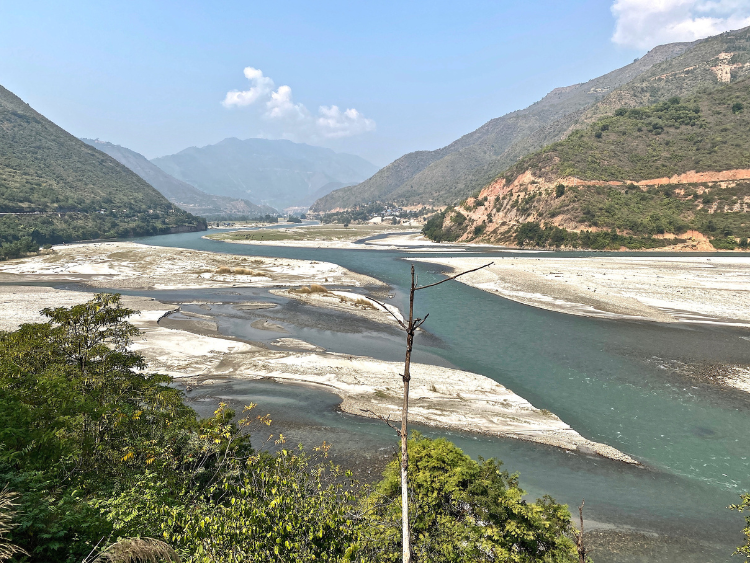
The mighty glacial river Sun Kosi has deeply carved and shaped this valley over millennia © Josef Essl/Trail Angels
Seven eight-thousanders at a glance
As the first warming rays of the sun kissed Phaplu awake, we crawled out of our sleeping bags. After an invigorating breakfast of muesli, porridge, pancakes and a warming tea, we packed our daypacks and dove into the 10-day trekking tour. We descended right at the beginning to the lowest point of the tour at almost 2,200 m, and then hiked through the wildly romantic Loding Valley with its white Sherpa houses built on the slopes, complete with blue roofs. Hidden between the houses stood in the middle of the valley slightly above the well-kept Loding gompa. The guided tour through the gompa was to be the first direct contact with a monk and the Buddhist faith. The following day, the landscape changed, especially as we hiked through different climatic and vegetation zones. Himalayan firs several meters thick and a good 40 meters high, overgrown with moss, lichens and ferns, alternated with Himalayan hemlocks and the Himalayan weeping pines, striking with their long soft needles. Tree-high and ancient rhododendron bushes towered in the undergrowth. It felt like we were in a typical jungle, rather than in the mountainous terrain of the Himalayas at over 2,700 meters above sea level. We passed through altitude level after altitude level, the forest became thinner and the view wider. And there the highest mountains of the world spread out in front of us like a string of pearls. First of all Mount Everest and in its wake Lhotse and Makalu greeted us. And in their shadow the not less imposing glacier mountains Nuptse, Ama Dablam, Kang Taiga, Thamserku, Kyashar and Mera Peak towered up before us. This view now accompanied us constantly up to the saddle “La Mani” at 3,440 m, where not only the glacier mountains in the northeast spread out in front of us, but now also the view to the contrasting south with its already gentle mountain peaks and deep-cut valleys wandered.
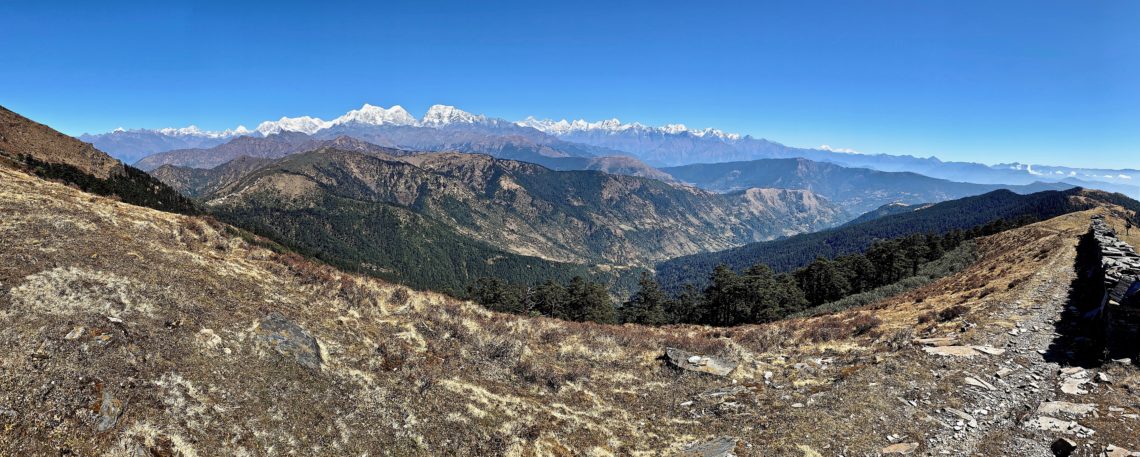
On the way to the Pikey Peak base camp, this grandiose mountain panorama opens up with the highest mountains in the world (Gauri Sankar in the back left, the Numbur massif in the middle, Mount Everest with its satellites behind it on the right) © Josef Essl/Trail Angels
Slowly but surely, the sun’s rays bathed the mountains in red. We paused and enjoyed this peace and quiet. After a rather cold night, we were awakened quite early by the warming rays of the sun, which made it possible to have breakfast under the open sky with a constant view of the Himalayan mountains. Again and again we asked ourselves if this view could be increased along the further route. Already the further stage to the Pikey Peak base camp will give us the answer. Already the ascent along a primeval forest-like ridge with moss-covered Himalayan firs, tree stumps charred by lightning strikes, evergreen rhododendron forests and with increasing altitude increasingly occurring deep red colored barberry bushes, put us in a constant state of amazement. Slowly but surely we stepped out of the timberline at over 3,700 m and the trees, mighty just a few minutes ago, ducked away, the rhododendron took over the supremacy and the light blue Himalayan gentian drew beautiful splashes of color in the increasingly barren high mountain landscape. In front of us rose the two rather inconspicuous Pikey Peak peaks, over 4,000 meters high, which according to stories offer unforgettable views of the highest Himalayan mountains. The base camp could still wait, because we decided to climb both peaks at once. At Pikey Peak I (4,070 m) a sea of prayer flags welcomed us. In front of us, the mighty Numbur with its satellites Khatang and Karyolung appeared for the first time. Framed behind them was a string of pearls of a seemingly infinite number of 6,000, 7,000 and 8,000-meter peaks – from Mount Everest to Mera Peak. But the altitude of over 4,000 m now also allowed unobstructed views to the west. We now also looked to Dhaulagiri, made out Annapurna and recognized the massive Manaslu. I don’t know any place in Nepal where you can admire 7 eight-thousanders from one point.

In the face of the highest mountains in the world (well visible is Mount Everest (r.) with its snow flag) we go up to Pikey Peak I © Josef Essl/Trail Angels

Great was the joy to have reached the two Pikey Peak summits. Some had never stood on such high mountains before. Welcomed by a sea of flags, another prayer flag could not be missing, which is just being attached to Pikey Peak II by Mingma (l.) and Pemba © Josef Essl/Trail Angels
With this panorama in front of us, we descended a short distance, crossed a gentle ridge and after a few minutes reached Pikey Peak II (4,065 m). Here, too, an almost infinite number of prayer flags greeted us. Although the distance to Pikey Peak I was only a stone’s throw away, new perspectives and mountain panoramas opened up for us. We looked far into the glaciated mountains of the Rolwaling Himal and here especially the shapely Gauri Sankar, an imposing rock and glacier mountain almost 7,200 m high, caught our eye. To the south, the mountains were already softer and everywhere on the slopes small mountain villages could be seen. The next day, very early in the morning, we should once again stand on this unique lookout peak, because we were told that at Pikey Peak II you not only have a unique mountain panorama in front of you, but you will probably also experience the most beautiful sunrise. We were tired, it was cold, and yet we set off from base camp in the pitch dark with headlamps. We quickly gained altitude and the daylight took over more and more. It was an indescribable moment when the sun sent its first rays to us and bathed the mountains, valleys, ridges, villages, ridges and peaks in a red. I looked into the happy faces of Birgitta, Theresa, 2x Sabine, Nicola, Kurt, Marius, Mingma and Pemba and knew that it was indeed one of the most beautiful sunrises.

Step by Step to the Sunrise on Pikey Peak II © Josef Essl/Trail Angels

The sunrise at Pikey Peak II is an unforgettable experience © Josef Essl/Trail Angels
On the way to the Buddhist sources of Nepal
With the hike to Junbesi, we are immersed in the Buddhist center of Nepal. Right in the village, the beautiful and colorful Tashi Thongmon Monastery catches our eye. It is our great fortune that Pemba Chhiri Sherpa, as a former monk, accompanies us on the entire tour. And that’s what makes this trip so special, because Pemba opens the doors to places where “normal” tourists can’t go. We will have a particularly lasting experience at Serlo Monastery. The panoramic location high above Junbesi and the colorful stairway to the monastery alone quickly immerse us in the Buddhist faith. In the inner courtyard there is a lot of activity, because 120 children and young people receive a Tibetan Buddhist education here over many years. We experience the young monks having lunch together, have interesting conversations with a lama and are even guided through the small, in-house museum with Buddhist pieces and sanctuaries.
The highlight of this cultural day is a visit to Thupten Choling Monastery, which was built above Junbesi on a mountainside in 1968. The monastery is surrounded by countless small houses where 300 nuns and 200 monks live today. Nearly 80% of them fled Tibet in 1959 and settled here in Solu. Thanks to Pemba, who used his personal connections as a monk, we were able to attend a puja with 150 nuns and monks in the evening. It was pure goose bumps when the prayers and chants were accompanied by Tibetan trumpets and drums. In any case, an unforgettable experience!

The beautiful and richly decorated staircase to the monastery Serlo © Josef Essl/Trail Angels

It is always a joy to meet these happy, content and humble people in Nepal. 120 young monks receive a solid Buddhist education here at Serlo Monastery © Josef Essl/Trail Angels
To the most sacred lake at the foot of the mighty Numbur massif
After the visit of the monasteries we went high up, because our goal was the 4.650 m high glacier lake Dudh Kunda at the foot of the 6.958 m high Numbur with its satellites. Up to there we climbed through rustic forests, over mountain meadows and ridges, reached extensive and panoramic yak high pastures, crossed high valleys traversed by glacial streams and finally reached along the mighty 1850 m glacial moraine the said sacred lake. And along the way, a very special mountain plant kept catching our eye, namely the edelweiss, which has its original home in the Himalayas and only migrated to the Alps after the Ice Age. Suddenly it was in front of us, the holiest lake of Nepal. With the many colorful prayer flags waving in the icy wind and the raging play of clouds around Numbur, Khatang and Karyolung, this grandiose high mountain landscape exuded a very special spirituality, aura and silence. We paused, enjoyed this breathtaking landscape and were also a little proud that we had made it this far. The night in the tent was exciting, because the ingredients with cloudless sky and almost 4,700 m above sea level promised some minus degrees. That it then became -16 ° C, was then but an exciting “sleeping experience”.

Mysterious and mystical, the sacred lake Dudh Kunda spreads out at the foot of Numbur, Khatang and Karyolung at almost 4,700 m above sea level © Josef Essl/Trail Angels
Thin air at just under 5,000 m
The desire to climb one of the surrounding 5,000-meter peaks turned out to be not so easy on closer inspection, because the mountain peaks around us were quite rugged, rocky and forbidding. We had survived the cold night in the tent without any problems and in the morning the sun sent us warming rays of sunshine very quickly. Cloudless sky, framed by a picturesque mountain panorama, we enjoyed our breakfast outside. The route for climbing a peak was then found after all, because the high valley directly in front of us offered itself, at the head of which rocky mountain peaks rose into the sky. No sooner said than done. Almost pathless, but without alpine challenges, we quickly gained altitude, because we were extremely well acclimatized. Breathtakingly beautiful mountain lakes glistening in the sun suddenly appeared amidst boulders. It was a real pleasure to explore this valley. As the altitude increased, we kept looking at our altimeters and increasingly wondered if the peak in front of us had already passed the 5,000 meter mark. We were no longer sure, but that did not dampen our good mood, because by now we were already higher than all the peaks in the Alps. And then we had reached our nameless rocky peak at 4,943 m above sea level. Even though we didn’t quite make the 5,000 m mark, there was still joy and pride in the faces. We enjoyed the time with clear view and sunshine on the summit extensively, looked over the crystal clear mountain lakes down to our tents and over to the dominant Numbur, whose highest point seemed for us now a little closer. With heavy hearts we said goodbye and descended to our tents, to then once again together with the entire team (incl. porters, kitchen crew …) to attach prayer flags at Dudh Kunda Lake. At the holiest lake this should be a sign that we are all equal and meet each other at eye level and respect.

What a view from the almost 5,000 m high nameless mountain peak over crystal clear mountain lakes over to the mighty Numbur © Josef Essl/Trail Angels

A beautifully laid out high-altitude trail leads from the Saharsbeni campsite at almost 3,900 m to Taksindu. The views keep wandering to the highest mountains of the Himalayas, which are lined up in front of us like a string of pearls © Josef Essl/Trail Angels
Pleasure walk along a mountain path
Slowly but surely it was time to say goodbye to Solu, but before that there was a real pleasure walk along an indescribably beautiful high trail from Saharsbeni base camp to Taksindu. Again and again we paused and looked back at the all towering Numbur. And the further we hiked out of the valley, the Solukhumbu with Mount Everest, Lhotse, Amadablam, Makalu, Mera Peak, Thamserku and many more came into focus. Below us we could make out deeply carved valleys with small villages and above us circled bearded and white-headed vultures. We crossed rhododendron forests, passed mighty Himalayan firs and descended through a shady jungle. Tired but happy, we finally reached Taksindu, where we attended an evening puja at the Taksindu Monastery.

With the last leg from Taksindu to Phaplu, it’s time to say goodbye to the Buddhism Sanctuary Trail. One last time we enjoy the Buddhist sights, like this stupa along the trail © Josef Essl/Trail Angels
Saying goodbye to the solu
How quickly the time flew! On our last leg, we hiked from Taksindu via Ringmo to Phaplu, but we still stopped at Chiwang Monastery, built in 1923, one of the oldest monasteries in Nepal, for an audience with the Lama. After a guided tour through the interior of the monastery, Pemba had once again “played” his connections, so that we paid a visit to one of the highest Lama, which is probably only given to a few. Individually we stood before him with white and silky khata, exchanged a few words and were blessed. Even though this “ceremony” lasted only a few minutes, it was an impressive experience for all of us.
Clouds had moved in and it was not far to Phaplu, which we could already make out from the monastery located almost 3,000 m above sea level. Thus, an unforgettable and for me personally the most beautiful trip in Nepal so far came to an end. However, the entire group from the participants to the guides, the porters, the kitchen crew and the cook, who conjured up incredibly good dishes on our plates every day, also contributed to this. I would like to thank all of them for this successful trip to the Buddhist monasteries in Solu.
Author
Josef Essl
Forester and biologist, 15 years with the Austrian Alpine Association/Department of Spatial Planning-Nature Conservation, 5 years Managing Director of CIPRA Austria and Head of the Alpine Convention Office. Since 2019 in the Technical Competence Center of D. Swarovski Tourism Services GmbH, author of relevant publications and author of numerous technical and alpine articles ©Josef Essl/Fair Trails®
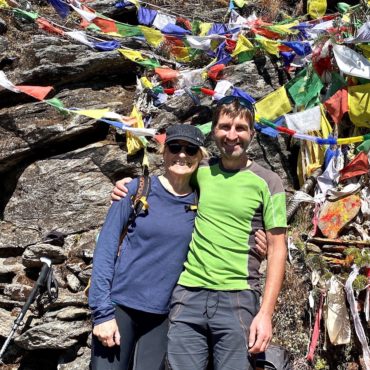
Related articles
Travel report autumn-hiking
©Trail AngelsLong-distance hiking in autumn Panorama Trail Southern Alps - autumn hiking can be so beautifulDo you know this too? You can hardly wait for summer after a long winter. And when it actually arrives - perhaps after a rainy spring - it's already over again....
Travel report Amazon of Europe Bike Trail
©Peter RupitschExperience the last great river wilderness in Europe in the border triangle of Croatia, Serbia and Hungary by bike Contents Author Travel Report Offers Who wrote this report for you? Peter Rupitsch from Heiligenblut am Großglockner is one of the most...
Get in touch
Every great journey begins with the first click.
If we could inspire you for responsible tourism, just get in touch with us. Who knows, maybe something big will come out of this first click together!
FOLLOW US
